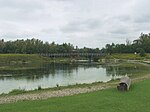SolarCity Linz
Auer+Weber+AssoziierteBuildings and structures in LinzLow-energy building

The solarCity is an energy-saving living district in Linz-Pichling, Austria, which provides living space for about 4,000 people. The houses were built using a low-energy design. The idea and motivation for providing energy efficient living arrangements stems from the fact that fossil fuels contribute to global warming and that their use should therefore be avoided. Planning of the project began in 1992. Since 1999, 1,300 apartments were gradually built during a 6-year period. The total cost of the project amounted to 190 million euros. Nearly two-thirds of which was used for the residential building, and only a third of the total cost was due to infrastructure.
Excerpt from the Wikipedia article SolarCity Linz (License: CC BY-SA 3.0, Authors, Images).SolarCity Linz
Lunaplatz, Linz Solar-City
Geographical coordinates (GPS) Address Nearby Places Show on map
Geographical coordinates (GPS)
| Latitude | Longitude |
|---|---|
| N 48.257777777778 ° | E 14.360555555556 ° |
Address
Volkshaus Pichling
Lunaplatz 4
4030 Linz, Solar-City
Upper Austria, Austria
Open on Google Maps









